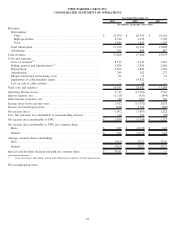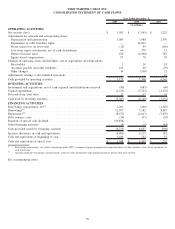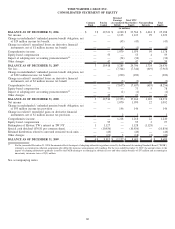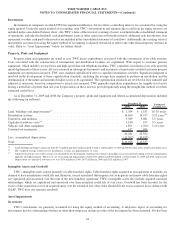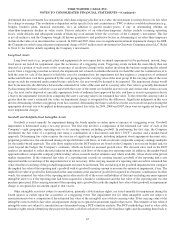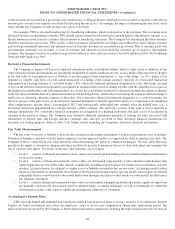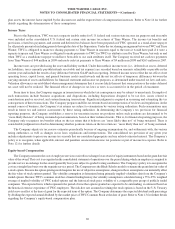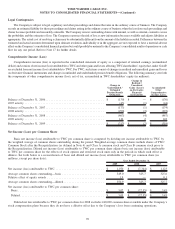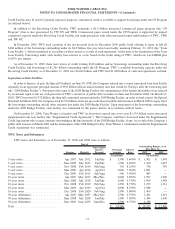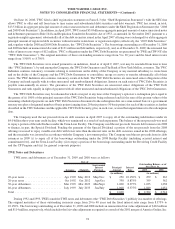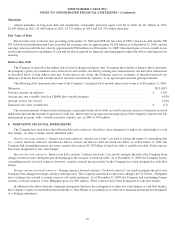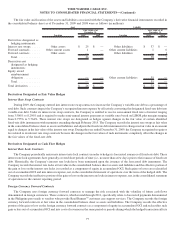Time Warner Cable 2009 Annual Report Download - page 80
Download and view the complete annual report
Please find page 80 of the 2009 Time Warner Cable annual report below. You can navigate through the pages in the report by either clicking on the pages listed below, or by using the keyword search tool below to find specific information within the annual report.extent revenues are recorded on a gross basis, any commissions or other payments to third parties are recorded as expense so that the net
amount (gross revenues less expense) is reflected in Operating Income (Loss). Accordingly, the impact on Operating Income (Loss) is the
same whether the Company records revenue on a gross or net basis.
For example, TWC is assessed franchise fees by franchising authorities, which are passed on to the customer. The accounting issue
presented by these arrangements is whether TWC should report revenues based on the gross amount billed to the ultimate customer or on
the net amount received from the customer after payments to franchising authorities. The Company has determined that these amounts
should be reported on a gross basis. TWC’s policy is that, in instances where the fees are being assessed directly to the Company, amounts
paid to the governmental authorities and amounts received from the customers are recorded on a gross basis. That is, amounts paid to the
governmental authorities are recorded as costs of revenues and amounts received from the customer are recorded as Subscription
revenues. The amount of such fees recorded on a gross basis related to video and voice services was $544 million in 2009, $524 million in
2008 and $495 million in 2007.
Derivative Financial Instruments
The Company recognizes all derivative financial instruments in the consolidated balance sheet as either assets or liabilities at fair
value. Derivative financial instruments are specifically designated, if certain conditions are met, as (a) a hedge of the exposure to changes
in the fair value of a recognized asset or liability or an unrecognized firm commitment (a “fair value hedge”) or (b) a hedge of the
exposure to variable cash flows of a forecasted transaction or a hedge of the foreign currency exposure of a forecasted transaction
denominated in a foreign currency (a “cash flow hedge”). For a derivative financial instrument designated as a fair value hedge, the gain
or loss on the derivative financial instrument is recognized in earnings in the period of change together with the offsetting loss or gain on
the hedged item attributable to the risk being hedged. As a result, the consolidated statement of operations includes the impact of changes
in the fair value of both the derivative financial instrument and the hedged item, which reflects in earnings the extent to which the hedge is
ineffective in achieving offsetting changes in fair value. For a derivative financial instrument designated as a cash flow hedge, the
effective portion of the gain or loss on the derivative financial instrument is initially reported in equity as a component of accumulated
other comprehensive income (loss) (“accumulated OCI”) and subsequently reclassified into earnings when the hedged item (e.g., a
forecasted transaction denominated in a foreign currency) affects earnings. The ineffective portion of the gain or loss is reported in
earnings immediately. For a derivative financial instrument not designated as a hedging instrument, the gain or loss is recognized in
earnings in the period of change. The Company uses derivative financial instruments primarily to manage the risks associated with
fluctuations in interest rates and foreign currency exchange rates and does not hold or issue derivative financial instruments for
speculative or trading purposes. Refer to Note 8 for further details regarding the Company’s derivative financial instruments.
Fair Value Measurements
The fair value of an asset or liability is based on the assumptions that market participants would use in pricing the asset or liability.
Valuation techniques consistent with the market approach, income approach and/or cost approach are used to measure fair value. The
Company follows a three-tiered fair value hierarchy when determining the inputs to valuation techniques. The fair value hierarchy
prioritizes the inputs to valuation techniques into three broad levels in order to maximize the use of observable inputs and minimize the
use of unobservable inputs. The levels of the fair value hierarchy are as follows:
• Level 1: consists of financial instruments whose values are based on quoted market prices for identical financial instruments
in an active market.
• Level 2: consists of financial instruments whose values are determined using models or other valuation methodologies that
utilize inputs that are observable either directly or indirectly, including (i) quoted prices for similar assets or liabilities in active
markets, (ii) quoted prices for identical or similar assets or liabilities in markets that are not active, (iii) pricing models whose
inputs are observable for substantially the full term of the financial instrument and (iv) pricing models whose inputs are derived
principally from or corroborated by observable market data through correlation or other means for substantially the full term of
the financial instrument.
• Level 3: consists of financial instruments whose values are determined using pricing models that utilize significant inputs that
are primarily unobservable, discounted cash flow methodologies, or similar techniques, as well as instruments for which the
determination of fair value requires significant management judgment or estimation.
Accounting for Pension Plans
TWC has both funded and unfunded noncontributory defined benefit pension plans covering a majority of its employees. Pension
benefits are based on formulas that reflect the employees’ years of service and compensation during their employment period. The
pension expense recognized by the Company is determined using certain assumptions, including the expected long-term rate of return on
68
TIME WARNER CABLE INC.
NOTES TO CONSOLIDATED FINANCIAL STATEMENTS—(Continued)


